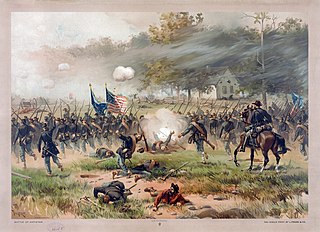
The Battle of Antietam, also called the Battle of Sharpsburg, particularly in the Southern United States, took place during the American Civil War on September 17, 1862, between Confederate General Robert E. Lee's Army of Northern Virginia and Union Major General George B. McClellan's Army of the Potomac near Sharpsburg, Maryland, and Antietam Creek. Part of the Maryland Campaign, it was the first field army–level engagement in the Eastern Theater of the American Civil War to take place on Union soil. It remains the bloodiest day in American history, with a tally of 22,727 dead, wounded, or missing on both sides. Although the Union Army suffered heavier casualties than the Confederates, the battle was a major turning point in the Union's favor.

The 20th Maine Infantry Regiment was a volunteer regiment of the United States Army during the American Civil War (1861–1865), most famous for its defense of Little Round Top at the Battle of Gettysburg in Gettysburg, Pennsylvania, July 1–3, 1863. The 133rd Engineer Battalion of the Maine Army National Guard and the United States Army today carries on the lineage and traditions of the 20th Maine.
The 5th Wisconsin Infantry Regiment was an infantry regiment that served in the Union Army during the American Civil War.

The 5th Michigan Infantry Regiment was an infantry regiment from Michigan that served in the Union Army during the American Civil War. The regiment was mustered into federal service in August 1861 and served in the Eastern Theater. It fought in all the major battles of the Army of the Potomac, including Seven Pines, the Seven Days Battles, Second Bull Run, Chantilly, Antietam, Fredericksburg, Chancellorsville, Gettysburg, the Wilderness, Spotsylvania, Cold Harbor, Petersburg, and Appomattox. The regiment was mustered out in June 1865.
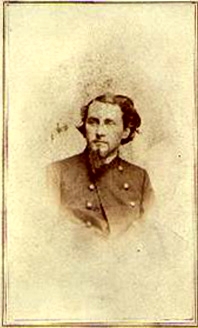
The 16th Michigan Infantry Regiment was an infantry regiment that served in the Union Army during the American Civil War.
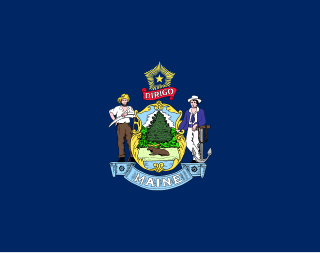
The 16th Maine Infantry Regiment was an infantry regiment that served in the Union Army during the American Civil War. The regiment was one of five raised in answer to the July 2, 1862, call by Lincoln for 300,000 volunteers for three years. The state of Maine's quota was 9,609. It was particularly noted for its service during the 1863 Battle of Gettysburg.

The 140th New York Infantry Regiment was a volunteer infantry regiment that was created on September 13, 1862, for the Union Army during the American Civil War. From January 1864 they wore a Zouave uniform.

The 2nd Regiment Massachusetts Volunteer Infantry was an infantry regiment in the Union Army during the American Civil War. Major George H. Gordon, a West Point graduate and veteran of the Mexican–American War, organized the unit's recruitment and formation. The 2nd Massachusetts was trained at Camp Andrew in West Roxbury, Massachusetts on the site of the former Transcendentalist utopian community, Brook Farm. Roughly half the regiment was mustered in on May 18, 1861 and the remainder on May 25, 1861 for a term of three years. The regiment saw extensive combat as part of the Army of the Potomac particularly during the Battle of Antietam and the Battle of Gettysburg.

The 35th New York Infantry Regiment, the "Jefferson County Regiment", was an infantry regiment of the Union Army during the American Civil War.

The 83rd New York Infantry Regiment, the "Ninth Militia," "Ninth Infantry National Guard," or "City Guard", was an infantry regiment of the Union Army during the American Civil War.

The 49th New York Infantry Regiment was an infantry regiment in the Union Army during the American Civil War.

The 102nd New York Infantry Regiment was an infantry regiment in the Union Army during the American Civil War. The regiment played a prominent part in numerous key battles in both the Eastern and Western theaters of the war. It was noted for its holding the high ground at the center of the line at Antietam as part of Stainrook's 2nd Brigade, Greene's 2nd Division of Mansfield's XII Corps. It was further highly regarded for its actions at the Battle of Gettysburg, the Battle of Lookout Mountain, and the Atlanta Campaign.

The 111th Pennsylvania Volunteer Infantry was an infantry regiment that served in the Union Army during the American Civil War. It was noted for its holding the high ground at the center of the line at Antietam as part of Stainrook's 2nd Brigade, Greene's 2nd Division of Mansfield's XII Corps.
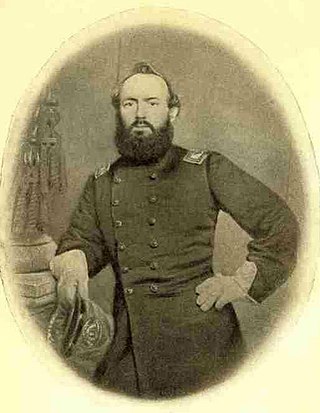
Albert Lewis Magilton was an American colonel who served the Union during the American Civil War who commanded the 4th Pennsylvania Reserve Regiment and who participated the Battle of Antietam under the command of George Meade.
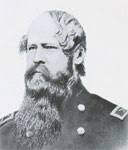
Timothy Dwight Morris (1817-1894) was an American colonel who commanded the 14th Connecticut Infantry Regiment during the American Civil War as well as commanding the 2nd Brigade of the 2nd Corps during the Battle of Antietam.

Charles Swain Lovell (1811-1871) was an American military officer and Brevet Brigadier General who commanded a brigade during several major battles of the American Civil War.

William Bingham Goodrich (1821-1862) was an American colonel and lawyer who served as commander of the 60th New York Infantry Regiment and of the 3rd Brigade, 2nd Division, XII Corps during the American Civil War before being killed in the early hours of the Battle of Antietam.

Norval E. Welch was an American colonel who commanded the 16th Michigan Infantry Regiment during the American Civil War before being killed at the Battle of Peebles's Farm.

Joseph Henry Barnes (1833-1906) was an American Brevet Brigadier General who commanded the 29th Massachusetts Infantry Regiment during the Eastern Theater of the American Civil War.

William Scott Worth was an American brigadier general of the American Civil War and the Spanish–American War. He was known for being the son of Major General William J. Worth and leading the 13th Infantry Regiment during the Battle of San Juan Hill.















